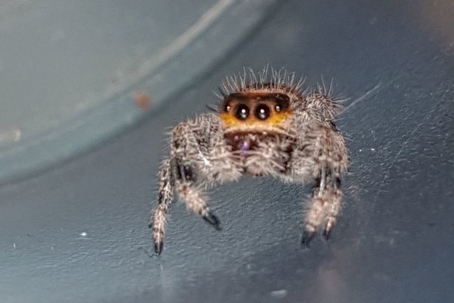Are Jumping Spiders Poisonous?
No, jumping spiders are not poisonous.
Are Jumping Spiders Venomous?
Yes, jumping spiders are technically venomous, but their venom is very mild and not dangerous to humans. These spiders use venom primarily to subdue and digest their small insect prey. In the rare event that a jumping spider bites a person, the bite might cause minor redness, itching, or slight swelling, similar to a mosquito bite. Serious reactions are extremely uncommon.
For pets or children, bites are generally harmless as well, but it’s always good to clean the bite area and monitor for any unusual symptoms.
Jumping Spider Venom
Jumping spider venom is a specialized biological cocktail designed primarily for hunting and subduing small prey like insects and other arthropods. It is composed mainly of neurotoxins and digestive enzymes. The neurotoxins target the nervous system of their prey, quickly immobilizing them, while the enzymes begin breaking down internal tissues to aid in external digestion.
For humans and larger animals, the venom is extremely mild. The proteins and enzymes in jumping spider venom are not adapted to affect mammals significantly, which is why bites rarely cause more than minor irritation—slight redness, swelling, or itching. There are no known cases of serious systemic reactions in otherwise healthy humans.
Jumping spider venom is highly effective for insects but virtually harmless to people, functioning more like a precision tool for hunting than a threat to larger animals.
Signs Of Jumping Spider Envenomation
Jumping spider envenomation in humans is extremely rare and almost always mild. When a bite occurs, the signs and symptoms are typically localized and limited to the area of the bite.
Common signs:
Redness or erythema – The skin around the bite may become slightly red.
Swelling – Mild swelling may appear, usually confined to the immediate bite site.
Itching or irritation – The bite may be itchy or slightly uncomfortable.
Minor pain or tenderness – Some people experience a small stinging sensation or tenderness that usually resolves quickly.
Small puncture marks – Often a pair of tiny punctures from the spider’s fangs can be seen.
Less common reactions:
Slight blistering at the bite site (rare).
Mild allergic reactions, such as hives, if a person is particularly sensitive (very rare).
Serious symptoms are virtually unheard of in healthy individuals, because jumping spider venom is not adapted to affect mammals significantly.
What To Do About Jumping Spider Envenomation
If you are bitten by a jumping spider, the steps you should take are straightforward because serious reactions are extremely rare. Here’s what to do:
Stay Calm
Jumping spider bites are typically harmless. Panic can worsen perceived pain or swelling.
Clean the Bite
Wash the area thoroughly with soap and water.
This reduces the risk of secondary infection.
Apply a Cold Compress
Use a clean cloth or ice pack wrapped in a cloth.
Apply for 10–15 minutes at a time to reduce swelling, redness, and discomfort.
Manage Symptoms
Itching or irritation: Use over-the-counter antihistamines or topical hydrocortisone cream.
Pain or tenderness: Mild pain can be managed with acetaminophen or ibuprofen if needed.
Monitor for Unusual Reactions
Mild swelling and redness are normal and usually resolve in a day or two.
Seek medical attention if you notice increasing redness, warmth, or pus (possible infection), severe swelling that spreads, or signs of an allergic reaction, such as difficulty breathing, hives, dizziness, rapid heartbeat
Prevent Future Bites
Avoid handling spiders directly.
Seal cracks in windows, doors, or walls where spiders may enter.
Keep areas around the home clean and free of clutter.
Most jumping spider bites are minor, self-limiting, and easily managed at home with cleaning, ice, and symptom relief.

